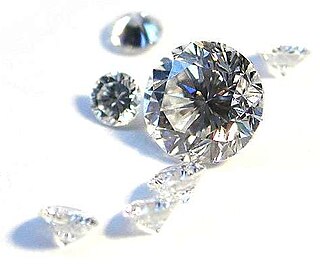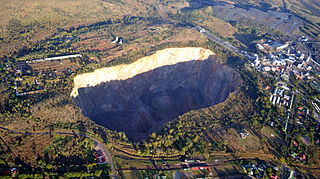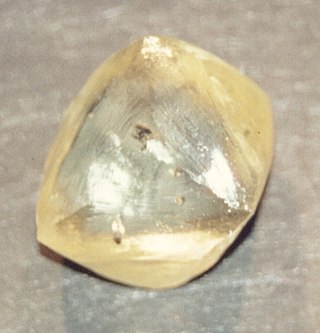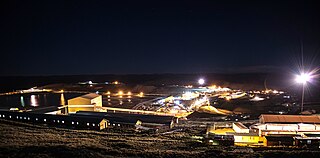Related Research Articles

Diamond cutting is the practice of shaping a diamond from a rough stone into a faceted gem. Cutting diamonds requires specialized knowledge, tools, equipment, and techniques because of its extreme difficulty.

The Cullinan Diamond is the largest gem-quality rough diamond ever found, weighing 3,106 carats (621.20 g), discovered at the Premier No.2 mine in Cullinan, South Africa, on 26 January 1905. It was named after Thomas Cullinan, the owner of the mine. In April 1905, it was put on sale in London, but despite considerable interest, it was still unsold after two years. In 1907, the Transvaal Colony government bought the Cullinan and Prime Minister Louis Botha presented it to Edward VII, the British king who reigned over the territory, and it was cut by Joseph Asscher & Co. in Amsterdam.

Tsavorite or tsavolite is a variety of the garnet group species grossular, a calcium-aluminium garnet with the formula Ca3Al2Si3O12. Trace amounts of vanadium or chromium provide the green color.

A diamond cut is a style or design guide used when shaping a diamond for polishing such as the brilliant cut. Cut does not refer to shape, but the symmetry, proportioning and polish of a diamond. The cut of a diamond greatly affects a diamond's brilliance — a poorly-cut diamond is less luminous.
The De Beers Centenary Diamond is, at 273.85 carats (54.770 g), the third-largest diamond to have been produced in the Premier Mine. Among top-color diamonds, only the Cullinan I and II are larger than the Centenary diamond. The Centenary Diamond is rated in color as grade D color by the Gemological Institute of America, which is the highest grade of colourless diamond and is internally and externally flawless. It was named the Centenary Diamond as it was presented in the rough for the Centennial Celebration of De Beers Consolidated Mines on 11 May 1988. The Centenary Diamond was unveiled in final form in May 1991.
The Great Chrysanthemum Diamond is a famous diamond measuring 104.15 carats with a pear-shaped modified brilliant cut, rated in colour as Fancy Orange-Brown and I1 clarity by the Gemological Institute of America. The Great Chrysanthemum is roughly the same size as the re-cut Kohinoor and almost three times the size of the Hope Diamond, The Great Chrysanthemum has the dimensions of 39.10 x 24.98 x 16.00 mm. and features 67 facets on the crown, 57 facets on the pavilion and 65 vertical facets along the girdle. The diamond, designed as a pendant, became the central focus of a necklace with 410 oval, pear-shaped, round and marquis diamonds.

The Premier Mine is an underground diamond mine owned by Petra Diamonds in the town of Cullinan, 40 kilometres (25 mi) east of Pretoria, Gauteng Province, South Africa. Established in 1902, it was renamed the Cullinan Diamond Mine in November 2003 in celebration of its centenary. The mine is a carrot-shaped volcanic pipe and has a surface area of 32 hectares. The mine rose to prominence in 1905, when the Cullinan Diamond – the largest rough diamond of gem quality ever found – was discovered there.

Harry Winston was an American jeweler. He donated the Hope Diamond to the Smithsonian Institution in 1958 after owning it for a decade. He also traded the Portuguese Diamond to the Smithsonian in 1963 in exchange for 3,800 carats of small diamonds.

Diamonds were largely inaccessible to investors until the recent advent of regulated commodities, due to a lack of price discovery and transparency. The characteristics of individual diamonds, especially the carat weight, color and clarity, have significant impact on values, but transactions were always private. With the standardized commodity as an underlying asset, several market traded financial instruments have been announced.

A gemstone desired to be used in jewelry is cut depending on the size and shape of the rough stone, as well as the desired piece of jewelry to be made. As a general rule, a cut gemstone will reduce the mass by about 50%.

The Letšeng Diamond Mine, found in the landlocked Southern African kingdom of Lesotho, is owned by Gem Diamonds, Ltd. and the government of Lesotho, and at an elevation of 3,100 m (10,000 ft) it is the world's highest diamond mine.
Gabriel S. Tolkowsky was a Belgian diamond cutter. He was known for cutting the famous Centenary Diamond, and was one of the world's most renowned diamond cutters. The great nephew of Marcel Tolkowsky, father of the modern round brilliant diamond cut, he is the sixth generation in his family to become well-known in the diamond cutting trade.

Diamond is one of the best-known and most sought-after gemstones. They have been used as decorative items since ancient times.
Gem Diamonds is a British-based global diamond mining business. It is headquartered in London and is listed on the London Stock Exchange. In 2017, the company generated a profit of $20.8 million.

Brown diamonds are the most common color variety of natural diamonds. In most mines, brown diamonds account for 15% of production. The brown color makes them less attractive to some people as gemstones, and most are used for industrial purposes. However, improved marketing programs, especially in Australia and the United States, have resulted in brown diamonds becoming valued as gemstones and even referred to as chocolate diamonds.
Graff is a British multinational jeweller based in London. It was founded by British jeweller Laurence Graff in 1960. A vertically integrated company, Graff operations comprise the design, manufacture and retail distribution of jewellery and watches.
The Woyie River Diamond was recovered on 6 January 1945 from the Woyie River near Koidu in eastern Sierra Leone. The uncut stone weighed 770 carats (154 g), and at that time it was the largest alluvial diamond ever found, and the third largest diamond discovered in Africa, after the Cullinan Diamond and the Excelsior Diamond. The alluvial Star of Sierra Leone, discovered at the Diminco mine in Sierra Leone in 1970, is larger at 968.9 carats (193.78 g) uncut.
The Cora Sun-Drop Diamond is the largest known yellow pear-shaped diamond, weighing 110.3 carats (22.06 g). It was sold for $10.9 million at Sotheby's auction in Geneva and set a world record price for a yellow diamond.

The DeYoung Red Diamond is a 5.03-carat unmounted rare red diamond. It is the third-largest red diamond in the world, and the only one on public display. Sydney DeYoung obtained the diamond, which was mistaken for a garnet, at a flea market. The diamond was given to the Smithsonian Institution after DeYoung's death in 1986.

Lesedi La Rona, formerly known in media as Karowe AK6 or as Quad 1 by the personnel at the mine, is the fourth-largest diamond ever found, and the third-largest of gem quality. It was found in the Karowe mine, in Botswana on 16 November 2015.
References
- ↑ BBC News Online, "Lesotho Diamond put up for sale", BBC, http://news.bbc.co.uk/2/hi/business/5409092.stm (accessed 2006-10-10)
- ↑ Mail & Guardian Online, "Biggest diamond of the century found in Lesotho", Mail & Guardian, http://www.mg.co.za/articlepage.aspx?area=/breaking_news/breaking_news__business/&articleid=285786 Archived 2007-10-01 at the Wayback Machine (accessed 2006-10-10)
- ↑ BBC News Online, "Massive diamond bought for $12m", BBC, http://news.bbc.co.uk/2/hi/europe/6034429.stm (accessed 2006-10-09)